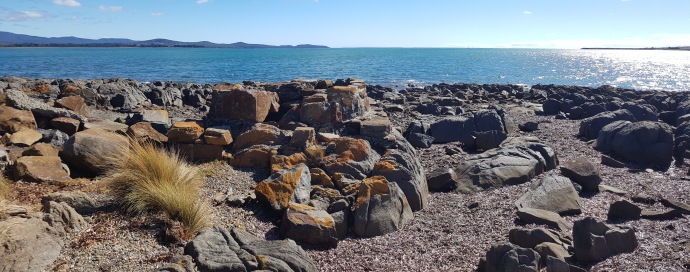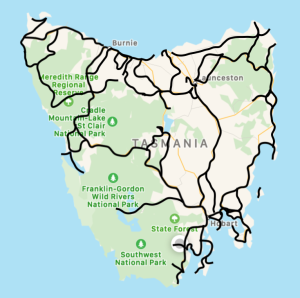8/4/19 To catch the evening ferry over from Devonport to Melbourne, that morning we departed Low Head, headed across the Tamar River’s Batman Bridge, went on to Latrobe and parked up for the remainder of the day in the campground there. Latrobe was just 15 minutes from Devonport, placing us on the starting block for the final run in to the terminal later that evening. At the slightly delayed time of 10:00pm, and following a long wait in the vehicle queue staring at the rear end of a Viscount caravan owned by Des and Gloria from Victoria who preferred UHF Channel 40, we boarded the Spirit of Tasmania, bade farewell to the Apple Isle, and hit the sack in our overnight cabin. All the anti-seasickness medications ingested and voodoo paraphernalia strapped on me and shoved in me had me sleeping the sleep of the innocent right through the night until woken by the breakfast alarm at five bells the next morning, very refreshed…only to look across at a rather tired-looking Di. The caffeine in the anti-seasickness medication had kept her awake most of the night, and by morning she’d gotten very little sleep. Still, one consolation was that she was able to provide me with a good account of what was apparently a bumpy crossing in parts. I was glad I slept through it…

Devonport – Spirit Of Tasmania Departure (Tas)

Devonport – Spirit Of Tasmania Departure (Tas)

Devonport – Spirit Of Tasmania Departure (Tas)
Di and I were aware of some low overhead bridges in Melbourne that de-roof the occasional unwary bus and truck. At 4.0 metres high, they are OK for most caravans, but the rail bridge on Montague Street had only 3 metres clearance, definitely not enough for the Kruiser. So, to ensure our exit from the Melbourne terminal would be smooth and uneventful, I got into preplanning the route to avoid the Montague Street Bridge. However, as we rolled out of the terminal and into the morning traffic, my well laid plan very quickly fell apart. A momentary hesitation caused us to miss a crucial turn, which had us ‘recalculating’, and winding our way through back streets and along main streets until we rounded a turn onto…yep, Montague Street, with its dreaded low overhead bridge visible in the distance. What the…! How did that stupid Google Maps manage to bring us there, bearing down on the van killer bridge in Melbourne’s morning peak-hour traffic! Fortunately, I’d read about the detour signs that divert high vehicles safely away from the bridge and, spotting one on the left, followed it into a side street and along to a right turn, and then along to another right turn, that took us…back to an intersection with bloody Montague Street and the bloody bridge just there on our left! What the heck sort of detour was that!
So there we were, now much closer to the bridge, facing onto the main road with bumper-to-bumper traffic both ways, not able to turn left because of the van killer bridge, and very little chance of breaking across the traffic to make a right turn away from the bridge. We were going to be there for life. But, I have to say, just when it seemed our darkest hour and all hope lost, Melbourne’s peak-hour drivers restored my faith in the human race…as the traffic both ways parted like the waters of the Red Sea, magically opening a hole before us, and like the winger of my youth, I saw the gap and took it, sidestepping and squeezing the rig through. I swear as we drove away from the bridge I could hear Handel’s Hallelujah Chorus playing in my head. Melbourne, you can keep your bloody low bridges all to yourself.
So, with that welcome, we were now back on the mainland after five months travelling throughout Tasmania. Reflecting on our time there, in the main we enjoyed it despite the criticisms sometimes mentioned in our blog. We loved the historical buildings and the many well-preserved examples of its colonial past. The erratic weather we disliked, sometimes intensely, and hated the dreadful goat-tracks passed off as (cough) roadways. Road signage was constantly confusing as to when to turn (I understood there was a consistent standard for road signage throughout Australia, but apparently that’s not the case), and fuel was a little more expensive. Making a full bodied red wine down there seemed problematical (their pinot noirs are award-wining, but not so much for me). And their thing for firewood and plantation forests had us fascinated. But for all that we disliked, there were many, many aspects of Tassie that more than compensated, like the scenery, and the cheeses, and the chocolates, and the scenery, and the food, and the beers, and the smoked salmon, and the scenery… The amount of fresh roadkill (mainly possums) was just crazy, but they have these things that clean it all up overnight, called Tasmanian Devils.
We now know that after managing the mountain roads down there with the van, we can handle any roads anywhere. And in terms of its weather, the island felt like it should be positioned somewhere off the coast of England. Yes, the weather had not been kind to us, but the locals kept saying it was an unseasonal year and they needed the rain, so I couldn’t begrudge them that. Tassie to us stood apart (excuse the pun) from anywhere else in Australia. It’s so compact, and yet took so long to get anywhere. In our travels around Australia, we’d left Tassie to last, being tucked away right down the bottom of the country and requiring an expensive ferry trip to get to. We’d always been intrigued by the place and the wildlife, and were glad we went.
Anyway, after escaping the madness of Melbourne’s low bridges and traffic, we chilled out for two days at the Tooradin Foreshore Reserve on the shores of Western Port, then headed for a few quite, relaxing days at a nice camp beside the Barwon River at the town of Winchelsea, 120kms south-west of Melbourne beyond Geelong, doing no touristy stuff at all, beyond taking the occasional walk around town and checking that the beer was cold at the Barwon Hotel. It was nice to just sit and not do anything for a few days. And the getting there was great – our first long, flat, straight stretch of road in five months…Woohoo!

Tooradin – Foreshore (Vic)

Tooradin – Foreshore (Vic)

Tooradin – Foreshore (Vic)

Tooradin – Foreshore (Vic)

Tooradin – Foreshore (Vic)

Winchelsea – Barwon River (VIC)

Winchelsea – Historic Bridge (VIC)

Winchelsea – Old and New Bridges (VIC)

Winchelsea – Barwon River (VIC)

Winchelsea – Barwon River (VIC)
“When I was a kid, the world was such a big place, and I had no idea that I would be afforded these great moments in between doing what I love to do. I’m able to actually choose places to go which have intrigued me for the last god knows how many years, and Tasmania’s always been one of those places. I see it all and yet I see so little because it’s so fast.” – Robert Plant, Led Zeppelin



























































































































































































































































































































































































































